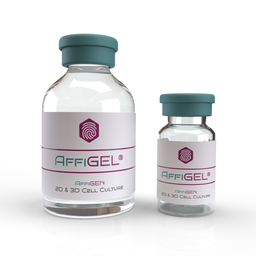AffiGEL® Matrix 3D Cell Culture Gel - Bundle
CAT# AFG-1BG-07
Size: 3 x 2 mL
AffiGEL® Matrix 3D VS Matrigel®
| AffiGEL® Matrix 3D | Matrigel® | |
| Composition | AffiGEL® Matrix 3D is derived from purified collagen proteins, specifically collagen Type I, which is a major component of the ECM in various tissues. | Derived from the EHS mouse sarcoma, Matrigel consists of a complex mixture of proteins, growth factors, and other ECM components, resembling the natural basement membrane. |
| Source and Purity | Typically obtained from purified collagen proteins, offering a more defined and pure ECM component. | It is derived from a tumor source (EHS sarcoma), potentially containing undefined growth factors and other tumor-related elements. |
| Applications | Primarily used for cell adhesion, migration, and tissue engineering applications due to its structural similarity to the ECM of connective tissues like skin, bone, and tendons. | Known for its use in supporting the growth, differentiation, and morphogenesis of various cell types, especially in angiogenesis, stem cell culture, and 3D cell culture models. |
| Ease of Use | Can be prepared in various concentrations and forms (e.g., gel, coating) with relative ease. | Often used as a gel at low temperatures but requires careful thawing and handling due to its sensitivity to temperature changes. |
| Transparency | Generally more transparent, facilitating better visualization and imaging of cells and structures. | Not very transparent, which can limit visibility in microscopic analyses or imaging techniques. |
| Consistency and Variability |
Offers more consistency in composition and properties between batches. | Known for batch-to-batch variability, which can impact experimental reproducibility. |
| Suitability for Cell Types |
Particularly suitable for cells that interact with collagen-rich environments, such as fibroblasts, endothelial cells, and some epithelial cells. | Supports a wide range of cell types but may not be optimal for certain specialized cells. |
Multiple Rigidity Levels
Generally, three common rigidity levels of AffiGEL® Matrix 3D are achieved through different concentrations
Gentle
AffiGEL® Matrix 3D with lower concentrations (around 1 mg/mL or less) tends to result in softer gels. These softer gels mimic tissues with lower rigidity, such as brain tissue or certain types of tumors.
Mid
Intermediate concentrations of AffiGEL® Matrix 3D (around 2-3 mg/mL) create gels of moderate stiffness. These gels can represent tissues like skin or muscle, offering an intermediate level of rigidity.
Rigid
Higher concentrations of AffiGEL® Matrix 3D (above 3 mg/mL) lead to stiffer gels. These gels can simulate tissues with higher rigidity, such as bone or tendons.
Preparation Protocol
The specific protocol for preparing the AffiGEL® Matrix 3D varies based on the desired rigidity, and the intended application. However, here's the general protocol
Materials:
- AffiGEL® Matrix 3D Lyophilized
- Buffer solution
- Neutralization solution (like sodium hydroxide, NaOH)
- Cell culture media or other additives (if necessary)
- Sterile equipment and containers
Prepare AffiGEL® Matrix 3D Solution
You need the AffiGEL® Matrix 3D Lyophilized powder and the Buffer Solution. Follow the user manual for reconstitution or dilution. Ensure the AffiGEL® Matrix 3D Solution is kept on ice to prevent premature gelation.
Adjust pH
AffiGEL® Matrix 3D Solutions are typically acidic. Use a neutralization solution (such as NaOH) to carefully adjust the pH. This step is crucial as the AffiGEL® Matrix 3D often form better at a specific pH range.
Optional Additives
At this stage, you can add other components to the collagen solution if needed for your specific experiment, such as growth factors, cells, or other biomaterials.
Gel Formation
Once the AffiGEL® Matrix 3D Solution is prepared and adjusted, it's ready for gelation. Transfer the AffiGEL® Matrix 3D Solution to the desired containers (plates, wells, dishes, etc.) and incubate at a suitable temperature, often at or close to physiological conditions (37°C) to allow the gelation process to occur. Gelation time can vary based on temperature and desired rigidity.
Cell Seeding (If Applicable)
If the AffiGEL® Matrix 3D is intended for cell culture studies, cells can be seeded onto the gel surface either during gelation or after gel formation. Follow standard cell culture protocols for seeding cells onto the AffiGEL® Matrix 3D.
Culturing and Maintenance
Following gelation and cell seeding, maintain the AffiGEL® Matrix 3D in suitable culture conditions, providing appropriate media and supplements as needed for the specific cell types and experimental requirements.
